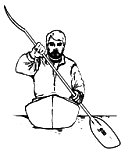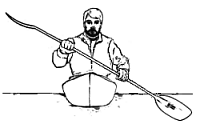
An Article from the Lightning Library
Other articles in this series:
Choosing a Paddle — What to Look for
Choosing a Paddle: Feather Angle
Mostly Touring Paddles: (white water and canoe are down a little farther)
For any kayak paddle, the shorter the better (within limits) is most efficient. The lower limit for t he best paddle length for you is dependent on several different variables. The width of the boat you paddle is probably the single most important factor. Paddling style would be second, and then your body size would be third.
Narrower boats like most conventional “hard-shell” “sit-in” kayaks require the least paddle length. Most inflatable kayaks are pretty wide and require a significantly longer paddle. The width of folding boats and “sit-on-tops” is usually somewhere between wide inflatables and narrow hardshells. There is an obvious width range within each style boat, probably enough to require some overlap between the different styles. For example, a really wide folder might require a longer paddle than a narrow inflatable.
The seat height of your boat might cause minor length changes, too. A higher seat would mean your hands are farther from the water for a given paddling style, dictating a paddle longer by approximately twice the seat height (half for each side of the boat). For instance, if you sat on a foot-high stool, you’d need a paddle two feet longer than you would if you sat on the bottom. (That’s a gross exaggeration, but it should make you more easily understand my point.)
Paddling style also makes a difference in paddle length. “High angle” paddlers, those who hold their upper hand farther above the boat deck and paddle with a closer to vertical shaft angle, can use a shorter paddle than a “low angle” paddler, one who holds his upper hand low, closer to the boat deck. I know, it sounds like it should be the opposite of that because both hands are closer to the water. However, a more horizontal shaft angle and a wide boat means that the shaft meets the water much farther from the boat, so it takes a longer shaft to get the blade into the water. Low angle paddling is a common sea touring style, but not found much in white water because of the basic inefficiency problems it causes in that paddling discipline.

High angle style 
Low angle style
The illustrations above show this. See that the high angle paddler has his upper hand above shoulder level and the low angle paddlers hand is below the shoulder. The terms high angle and low angle come from the angle of the shaft in relation to the water surface. The high angle shaft is steeper, resulting from the higher upper hand position. The lower hand of both paddlers is about the same position, but the shaft length between the hand and the blade must be longer to get the whole blade under water. The blade is farther from the boat which turns the boat a little with every stroke and therefore requires more work in steering compensation.
A paddlers body dimensions actually have only a minor bearing on paddle length. A tall paddler sitting on the floor can reach it with his hands just as well as a short person. The only reason a taller paddler might want a little longer paddle is because a narrow handspread is awkward for them, and that doesn’t require much additional length — maybe eight inches from the shortest to the tallest in adults. Most paddles sold are actually within about a four inch range (but, so are most people).
The seats in a kayak are usually pretty low, but they can vary. Just an inch or two can make a noticeable difference in stroke mechanics with the wrong paddle length.
The above tells us that someone paddling a wide inflatable using a low angle paddling style needs a longer paddle than a high angle paddler in a narrow little hardshell whitewater boat. Paddlers in other boats would be somewhere in between the two extremes. Varying seat heights just add a little complexity. You would be better off choosing a required paddle SHAFT length than an overall paddle length because blade lengths vary as much as 8 inches between brands and models. Given a blade length of around 17-18 inches, the next paragraph will give you some quick and dirty rules of thumb for overall paddle length.
I would recommend the average paddler using high angle style in a relatively narrow hard shell sea kayak try a paddle about 218-220 cm (86 inches) long, for starters. Taller or smaller paddlers go an inch or two longer or shorter, but don’t be afraid to try even shorter than that. Average paddlers in wider boats, including most single folders, might want to try a 225 cm (88 inches) or so paddle. Wider doubles and inflatables might try a 230 cm (90 inches) or so. Those using a low angle paddling style will probably need to up their paddle length some. Try about 10 to 15 cm (2 to 3 inches) longer on each of the above categories as a start. I can’t imagine the boat / style / person combination that would require anything longer than 245 cm (96 inches).
The typical sea kayaker uses a paddle that is much too long for decent efficiency. Don’t make work for yourself. Learn efficient technique using properly designed and sized paddles, and your boating fun will increase enormously. You will be much less tired at the end of a long day’s paddle, especially into the wind.
White Water Paddles:
The recommendation
for white water kayak paddles is the same. The shorter the better, within
limits. Much of the above sea kayak length information is also relative to
white water, except that white water paddlers use much shorter paddles, and
few, if any, use a low angle paddling style. That keeps the length range
differences down and makes length selection much easier.
Most white water kayakers use paddles in the 198 to 204 cm range, only a little over a two inch difference in length. The actual range is probably about 190 to about 210 cm, or still less than eight inches. Those on white water or sea kayak sit-on-tops will probably want something around 210 to 215 cm, and inflatable paddlers might need a bit more length, say 220 to 230 cm, or so.
Again, boat width and seat height are more of a factor than the paddler’s body dimensions. I know kayakers who are relatively tall (6′- 3″) who use short (195cm) paddles for white water. They claim it works for them, and they do very well with their short paddles, indeed.
Take a look at the presently manufactured length range differences between white water and sea kayak paddles. The maximum white water range difference (195-210cm = 6″) for hardshell boats is less than the minimum range difference (220-240cm = 8″) for hardshell sea kayaks, and the body type range for paddlers is the same for both. The differing paddling styles and wider range of boat styles in touring are most of the cause of the discrepancy.
Canoe Paddles:
Seat height above the
water surface is the main determinant of canoe paddle length.
Marathon canoe racers use bent shaft paddles as short as 48 inches and up to about 54 inches. Flat water cruisers might want them just a tad longer, say 2 inches. White water cruisers will prefer paddles in the 54 to 58 inch range. Slalom racers will usually be between 56 and 60 inches. I’ll see if I can find a flatwater canoeing site that I can link to for good paddle length information.
Article courtesy of Hank Hayes,
Lightning Paddles
Copyright © 1996, 1997,
1998, and legal fine print
Revised: 25 June,
1998
http://www.paddles.com/library/basics3.html
